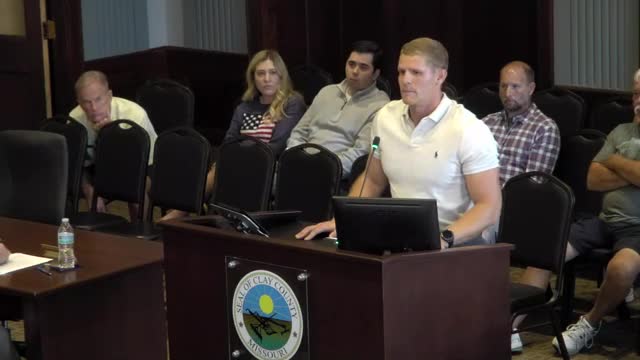Residents rally against controversial subdivision development plans
September 04, 2024 | Clay County, Missouri
This article was created by AI summarizing key points discussed. AI makes mistakes, so for full details and context, please refer to the video of the full meeting. Please report any errors so we can fix them. Report an error »

In a recent government meeting, concerns were raised regarding a proposed subdivision in Clay County, which aims to develop 41 lots on a 3-acre parcel. Local residents and officials expressed significant apprehension about the project's feasibility and its potential impact on the community and environment.
Key issues highlighted included the inadequacy of existing infrastructure to support the development. The Clay County Public Water Supply District No. 9 has not confirmed whether water can be supplied to the area, and the developers have not proposed any upgrades to essential services such as sewer lines or drainage systems. Instead, they plan to rely on individual septic systems for each lot, a solution deemed impractical given the area's soil quality challenges.
Residents emphasized that the proposed lot sizes fall below the recommended 5-acre minimum for individual septic systems, raising concerns about environmental sustainability and public health. The area is currently zoned for agriculture and conservation, with community guidelines suggesting at least 20 acres per lot to preserve the natural landscape.
Community feedback collected through surveys indicated a strong preference for new developments to be located closer to urban centers rather than in unincorporated areas. Many residents fear that the subdivision would erode the rural character and natural beauty that attracted them to the region, potentially decreasing property values by 10% or more.
Safety concerns were also voiced, particularly regarding traffic on Highway 92, which is already known for its hazardous conditions. Residents urged officials to consider the implications of increased traffic from the proposed development, especially given its distance from the nearest town.
The meeting underscored a broader debate about land use and development in Clay County, with residents questioning the potential precedent this subdivision could set for future projects. They argued that ignoring established county codes and community frameworks could lead to significant changes in the character of the area, transforming it into something unrecognizable.
As discussions continue, the community remains vigilant, advocating for adherence to existing regulations and the preservation of their rural lifestyle.
Key issues highlighted included the inadequacy of existing infrastructure to support the development. The Clay County Public Water Supply District No. 9 has not confirmed whether water can be supplied to the area, and the developers have not proposed any upgrades to essential services such as sewer lines or drainage systems. Instead, they plan to rely on individual septic systems for each lot, a solution deemed impractical given the area's soil quality challenges.
Residents emphasized that the proposed lot sizes fall below the recommended 5-acre minimum for individual septic systems, raising concerns about environmental sustainability and public health. The area is currently zoned for agriculture and conservation, with community guidelines suggesting at least 20 acres per lot to preserve the natural landscape.
Community feedback collected through surveys indicated a strong preference for new developments to be located closer to urban centers rather than in unincorporated areas. Many residents fear that the subdivision would erode the rural character and natural beauty that attracted them to the region, potentially decreasing property values by 10% or more.
Safety concerns were also voiced, particularly regarding traffic on Highway 92, which is already known for its hazardous conditions. Residents urged officials to consider the implications of increased traffic from the proposed development, especially given its distance from the nearest town.
The meeting underscored a broader debate about land use and development in Clay County, with residents questioning the potential precedent this subdivision could set for future projects. They argued that ignoring established county codes and community frameworks could lead to significant changes in the character of the area, transforming it into something unrecognizable.
As discussions continue, the community remains vigilant, advocating for adherence to existing regulations and the preservation of their rural lifestyle.
View full meeting
This article is based on a recent meeting—watch the full video and explore the complete transcript for deeper insights into the discussion.
View full meeting
